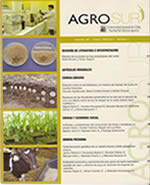Replacing a permanent pasture and its effect in the first year on a commercial dairy farm
Main Article Content
Abstract
The objective was to assess the impact of replacing a permanent pasture with a reseeded pasture on system productivity and product quality in the first year of establishment under commercial conditions management. Dairy cows were allocated to treatment based on pasture availability at the start of the season following standard commercial practices. Seventy autumn-calved cows grazed a high sugar grass pasture (14.1 ha reseeded in September 2015) and 55 grazed a permanent pasture (12.1 ha) from April to June 2016. Pastures snip samples were taken to assess nutritional composition every two weeks. Milk production and composition was measured on 4th May and 10th June. A slightly higher content of water soluble carbohydrate was observed in May on the reseeded sward (27.1 vs. 25.8%) coinciding with a higher milk yield (24.6 vs. 22.9 L d-1 per cow), lactose content (4.41 vs. 4.34%), and a lower somatic cell account (59,400 vs. 113,300 cell mL-1), compared to the permanent pasture. Pasture varied in nutritional value across the study. In June, no differences in milk production or composition were observed. However, the reseeded sward was estimated to produce 12.3% more milk per ha than the permanent pasture during the experimental period (113.8 vs. 101.3 L ha-1 d-1), driven by the greater carrying capacity of the sward (5 vs. 4.5 LU ha-1). This farm case study shows the potential of a reseeded pasture to outperform permanent pasture even in the first year of establishment at a farm system scale.

